Mcgraw-Hill Textbook Answers Pre-Calculus 11 Student Edition Chapter 1 Sequences and Series
Page 22 Problem 1 Answer
Here, we are given 30 disks.
The sequence to be considered is 1, 2, 3, 4, 5.
We are asked to represent each number by small counting disk which are to be arranged in a triangular table.
The series may be represented as:
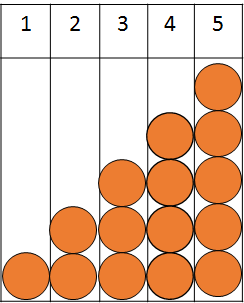
The answer is:
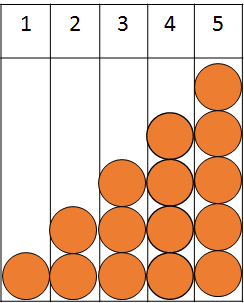
Page 22 Problem 2 Answer
As per the answer of part (a) is:
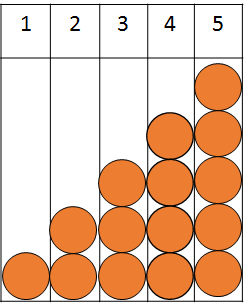
To find: The sum of numbers in the sequence.
Here, we can sum the numbers to find the answer.
The sum of numbers in the sequence is:
Read and Learn More Precalculus Textbook Mcgraw Hill Answers
1 + 2 + 3 + 4 + 5 = 15.
The answer is 15.
Page 22 Problem 3 Answer
As per the answer of part (a), we have:

As per answer of part (b), we have the sum of numbers of sequence as 15.
To find: The relation between the number of disks used with the sum of sequence.
We can find the number of disks used by counting the number of disks.
The number of disks used here are 15 and sum of numbers of sequence is also 15.
Therefore, we can conclude that the number of disks used is equal to the sum of numbers of sequence.
The number of disks used is equal to the sum of numbers of the sequence.
Mcgraw-Hill Textbook Answers
Page 23 Problem 4 Answer
We have to draw a triangle with the help of disks to represent the sequence 1, 2, 3, 4, 5.
We are required to copy the triangle of disks.
The answer can be:

The answer is:

Page 23 Problem 5 Answer
As per the answer of part(a), we have the following triangle:

We are required to rotate the triangle by180°.
On rotating the triangle, we get:
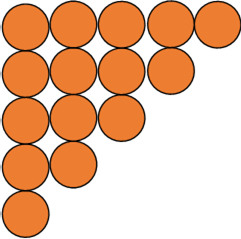
Now, when both the triangles are joined, the rectangle formed is:
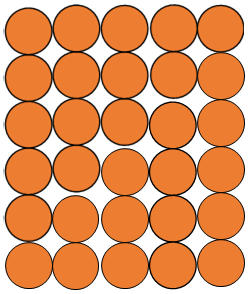
The rotated triangle is:
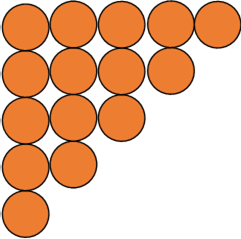
The triangle formed by joining the triangles is:
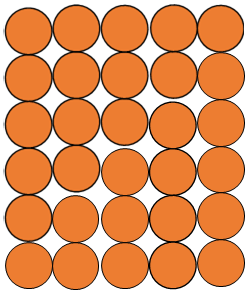
Page 23 Problem 6 Answer
As per the answer of part (b), we have the following rectangle:
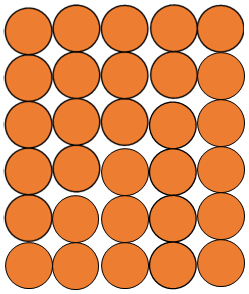
To find: The number of disks in the length and width of the rectangle.
Let us count the number of disks in vertical and horizontal direction.
The number of disks in the vertical direction is 6 so length is 6.
The number of disks in the horizontal direction is 5 so width is 5.
The length is 6 and width is 5.
Mcgraw-Hill Textbook Answers
Page 23 Problem 7 Answer
As per the answer of part (b), the rectangle obtained is:
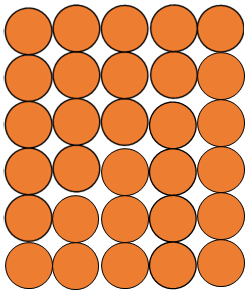
As per answer of part (c), the length is 6 and width is 5.
To find: The number of disks in the area of rectangle.
The area can be found by multiplying the length with the width of rectangle.
The area of rectangle or the number of disks in the area of rectangle can be found as: 6⋅5=30.
Or simply, we can also count the number of disks as 30.
The answer is 30.
Page 23 Problem 8 Answer
As per the answer of part (d), the area of rectangle is equal to 30 sq units.
To find: The relation between the sum of sequence 1, 2, 3, 4, 5 and area of the rectangle.
First, let us find the sum of numbers of sequence.
The sum of sequence is1+2+3+4+5=15.
And area of rectangle is30=15∗2.
Therefore, the area of rectangle is twice the sum of sequence.
Area of rectangle is equal to twice of sum of sequence.
Page 23 Problem 9 Answer
Earlier, we found the area of rectangle that was made by first arranging the number of disks in sequence 1, 2, 3, 4, 5.
And then this triangular arrangement was rotated180°
and joined with original triangle to form a rectangle as shown below:
Then area of this rectangle was found by multiplying 5 with 6 which comes out to be equal to the number of disks used i.e. 30.
Now, we are asked to develop a formula to find the sum of n consecutive integers.
Here, we can see that the sum of first 5 consecutive integers is 15.
The rectangle thus formed contains the width as 5 which is equal to the number of integers and length is 6 which is 1 more than the number of integers.
The area thus found is 30 which is the double of product of the number and number plus 1.
And the sum of 5 consecutive integers is half the area of rectangle.
Therefore we can write the formula as:
Mcgraw-Hill Textbook Answers

Sum of n consecutive integers=n(n+1)/2.
The formula is: Sum of n consecutive integers=n(n+1)/2.
Page 23 Problem 10 Answer
Earlier, we found the area of rectangle that was made by first arranging the number of disks in sequence 1, 2, 3, 4, 5.
And then this triangular arrangement was rotated180°
and joined with original triangle to form a rectangle as shown below:
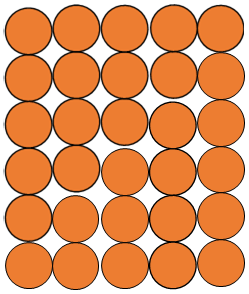
Then area of this rectangle was found by multiplying 5 with 6 which comes out to be equal to the number of disks used i.e. 30.
Then the sum of five consecutive integer is half of 30 which is 15.
We are asked to find how this method is related to Gauss method.
In Gauss method, we add the original series to its reverse and then we divide by 2.
If we closely observe, both the methods of finding the sum of n consecutive integers are working in similar manner.
Both the methods are working in similar manner.
Mcgraw-Hill Textbook Answers
Page 23 Problem 11 Answer
We are given that we have to start from the center of the grid and we have to draw a segment of one unit vertically upwards.
The segment can be drawn as follows:
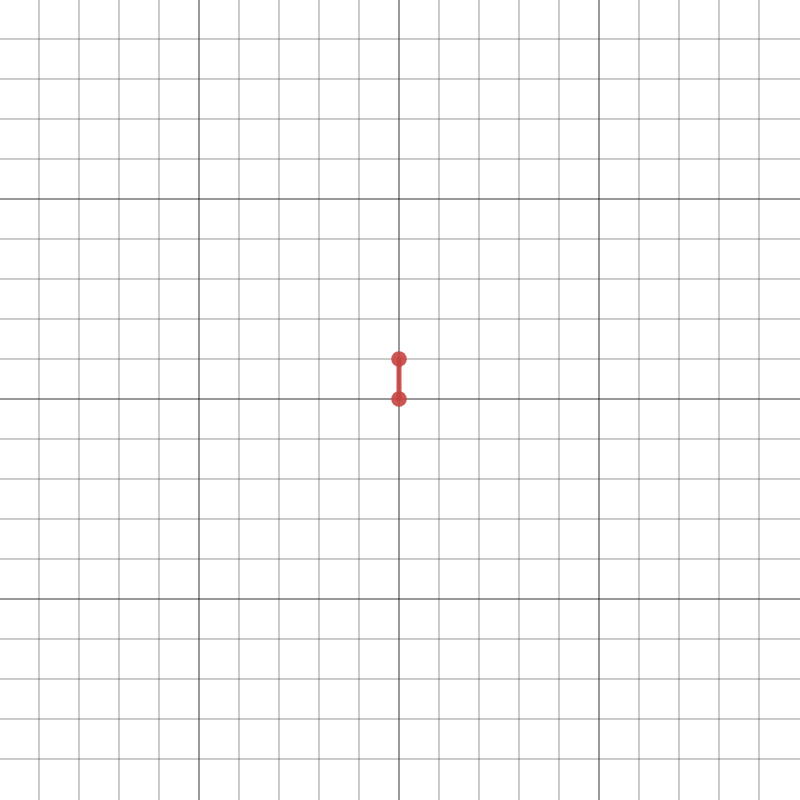
The answer is:
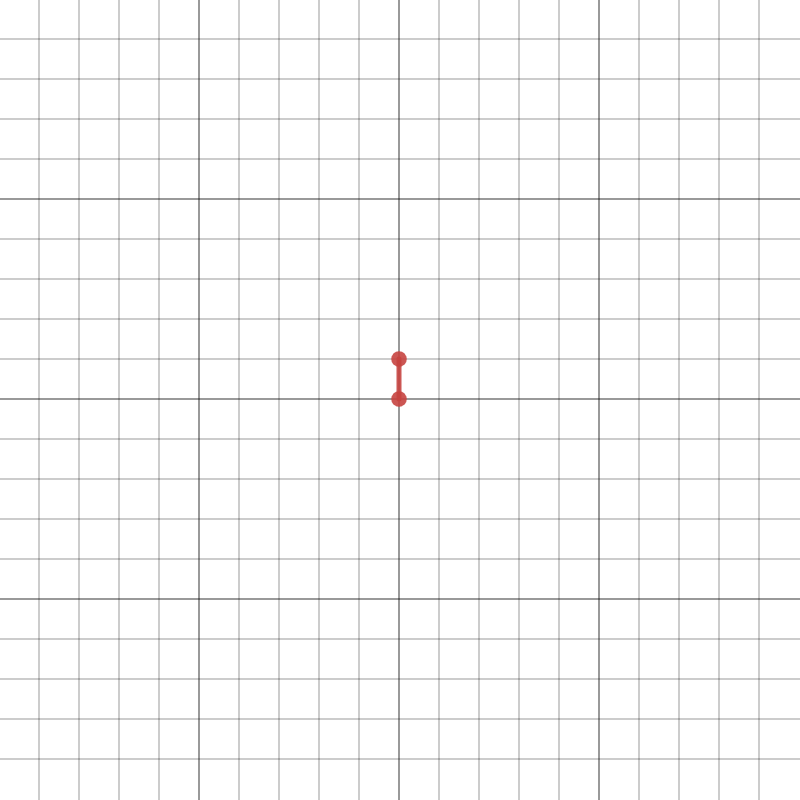
Page 23 Problem 12 Answer
As per the answer of part(a), we have the following graph:
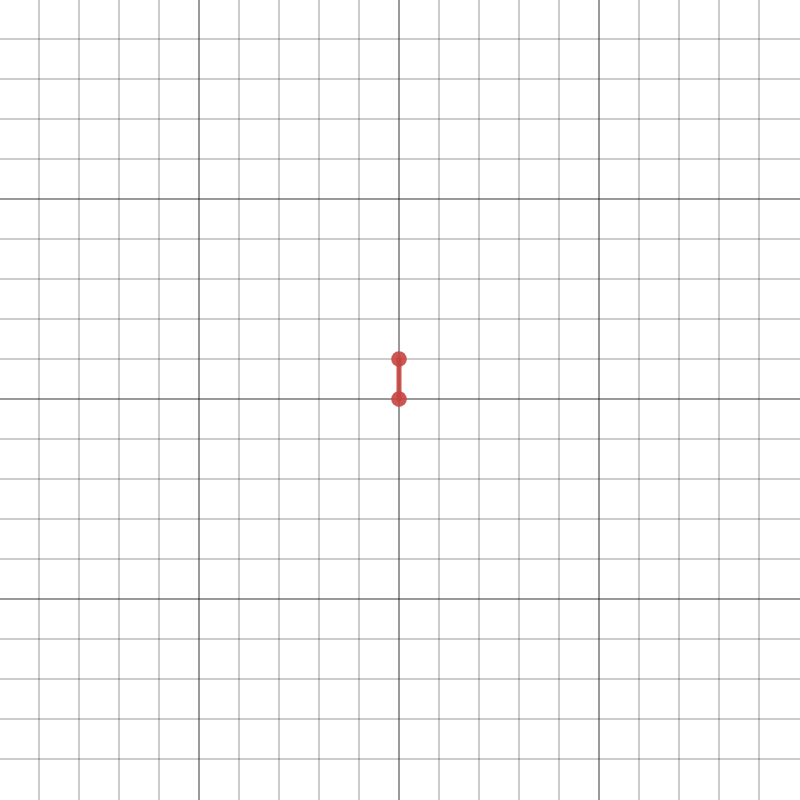
We are asked to draw another line to right of previous segment and is one unit longer than previous segment.
The line segments can be represented as follows:
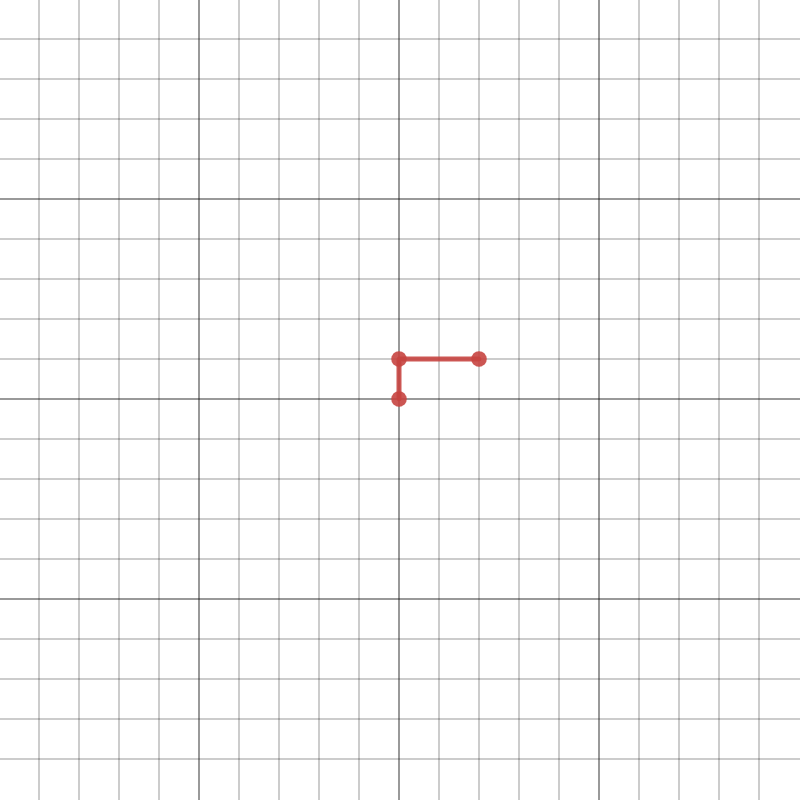
The answer is:

Page 23 Problem 13 Answer
As per the answer of part (b), we have:
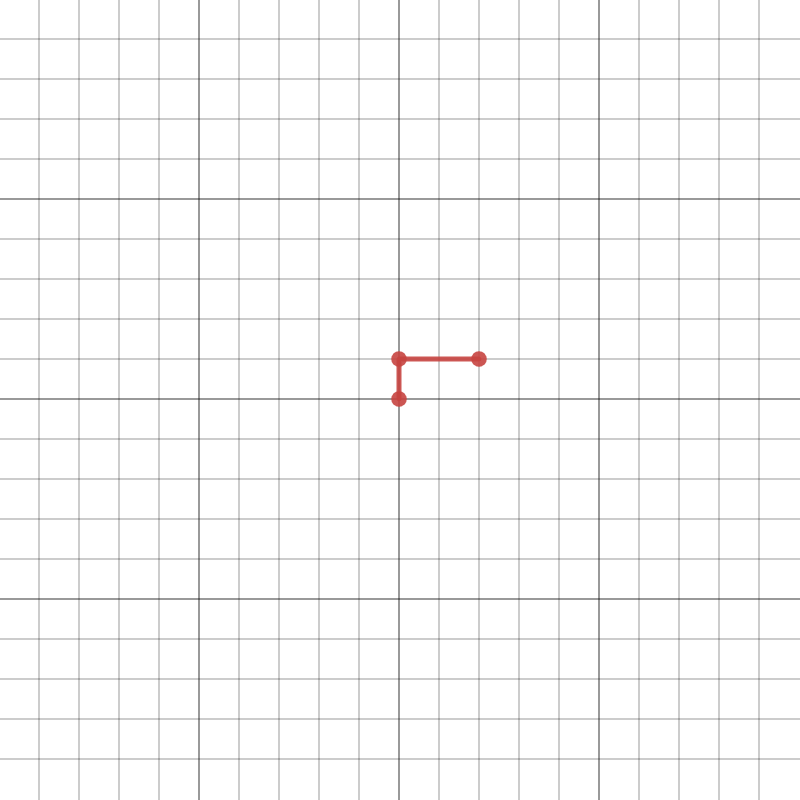
Now, we have to draw another segment vertically downwards which is one unit more than the previous segment.
The diagram can be draw
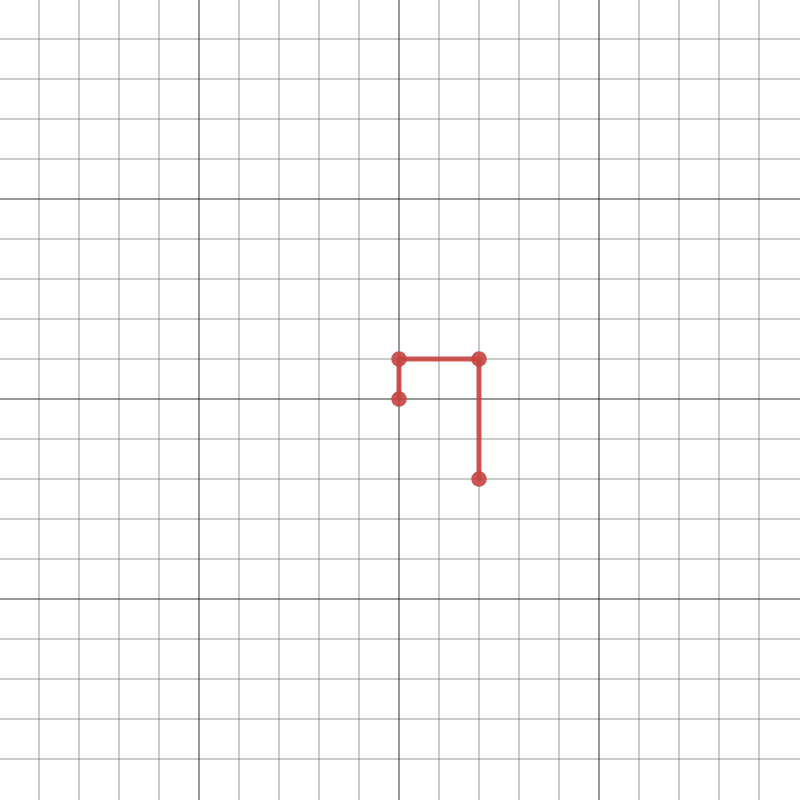
The answer is:
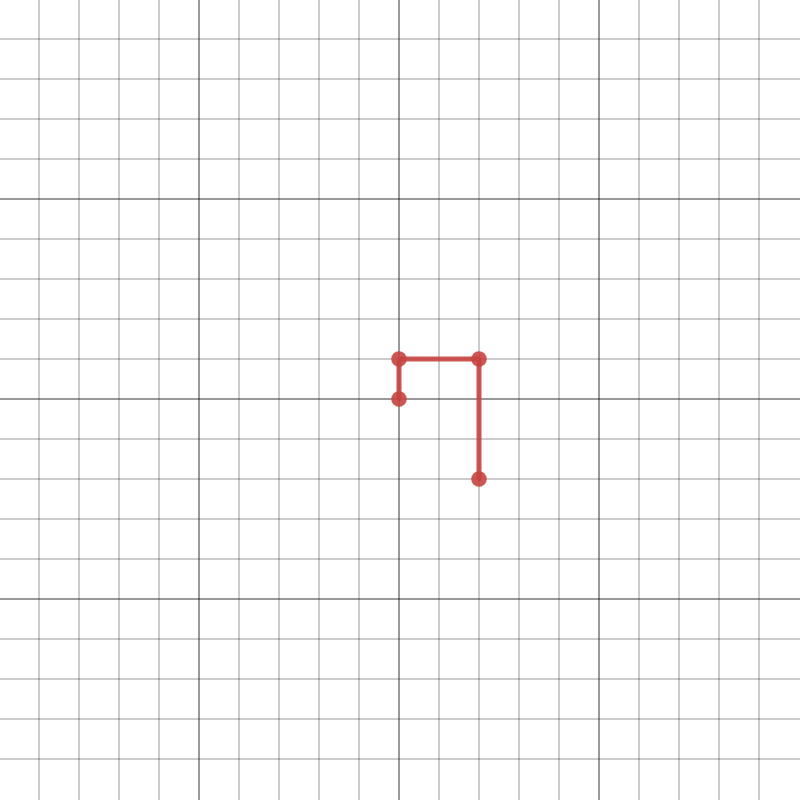
Page 23 Problem 14 Answer
As per the answer of part (c), we have the following diagram:
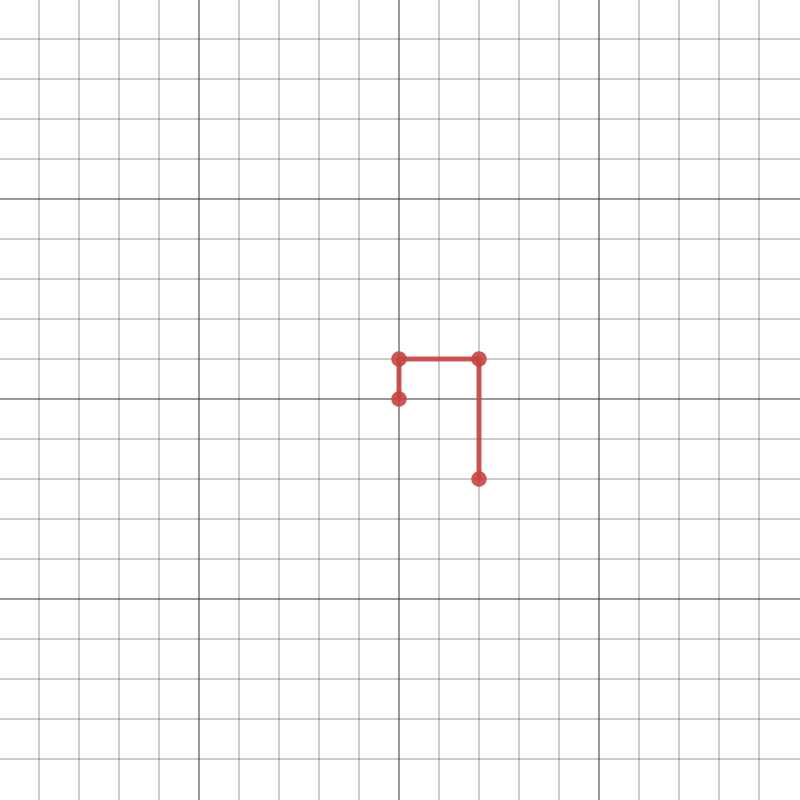
To find: The graph after continuing to 14 segments.
The graph can be drawn as follows:
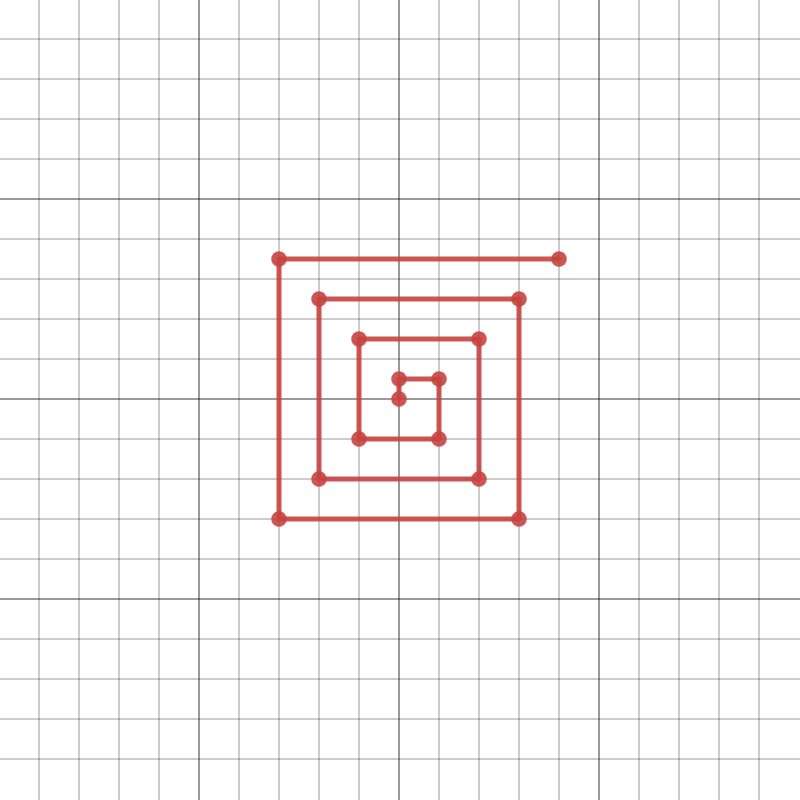
The answer is:

Page 23 Problem 15 Answer
We are given that we have to follow the following steps:
- Draw a line segment 1 unit up.
- Draw a line segment to the right 2 units.
- Draw a line segment downwards 3 units.
This pattern is repeated 14 times.
We are asked to record the lengths of segments as an arithmetic sequence.
The arithmetic sequence may be written as: 1, 2, 3, 4, …., 14.
Where first term is 1 and common difference is also 1.
The answer is: 1, 2, 3, 4, …., 14.
Where first term is 1 and common difference is also 1.
Mcgraw Hill Precalculus Textbook Answers
Page 23 Problem 16 Answer
As per the answer of part (a), the arithmetic sequence to represent the spiral is:
1, 2, 3, …. , 14.
To find: The total length of the spiral.
We are required to find the sum of these 14 terms here for calculating the total length of the spiral.
The sum to be found is:
1 + 2 + 3 + 4 + … + 14
We can take seven terms each to make the sum easier.
The sum of first seven terms is 1+2+3+4+5+6+7=28.
The sum of next seven terms is8+9+10+11+12+13+14=77.
Now, the total sum is 28+77=105.
The answer is 105.
Page 23 Problem 17 Answer
As per the answer of part (a), the sum of sequence to be found is 1, 2, 3, 4, … , 14.
As per answer of part (b), the sum is 105.
Here, we are asked to explain the method by which we have found the sum.
The method used to find the sum is:
- Write the sequence in two smaller haves.
- Add them separately.
- Add both the results.
Page 23 Problem 18 Answer
Given 14 terms as:
1, 2, 3, 4, …. , 14.
To find: The sum of numbers using Gauss method.
Let us rewrite the series in reverse order first and add them.
Here, first the sequence can be written again in reverse order and then added to original sequence.
1+2+3+⋯+14
14+13+12+⋯+1
−−−−−−−−−−−−−−−−−−−−−−−−−−−
15+15+15+⋯+15(14 times)
⇒14⋅15
⇒210
Now, the series has been added twice, therefore the sum is:
210/2=105.
This sum is same as already calculated by adding the terms simply.
The answer is 105 which is same as already calculated by adding the numbers algebraically.
Mcgraw Hill Precalculus Textbook Answers
Page 23 Problem 19 Answer
The series to be added using Gauss’s method is:
1+2+3+⋯+14.
As per part (a), number of terms were equal to 14.
Sum of each pair was 15.
To find: The sum of each pair and total number of terms.
Let us observe the part (a).
As per part(a), the number of terms are 14 which is equal to the number of segments itself.
And the sum of each pair was 15 which is 1 more than the number of terms.
The sum of each pair was 15 and number of terms were 14.
Sum of each pair was 1 more than the number of terms.
Page 23 Problem 20 Answer
Given 20 segments in a spiral where length of each segment is one more than the previous segment.
To find: The formula to find the sum of 20 such segments in the spiral.
First, let us derive the formula if n segments were there in the spiral.
Deriving the formula:
Let the series be 1, 2, 3, …. , n.
Adding the term and its reverse:
1+2+3+⋯+n
n+(n−1)+⋯1
−−−−−−−−−−−−−−−−−−
(n+1)+(n+1)+…+(n+1) [n times]
⇒n(n+1)/2
Finding the sum for 20 terms:
Now, putting n=20:
The sum of 20 segments in the spiral is:
20(20+1)/2
⇒10⋅21
⇒210
The answer is 210.
Mcgraw Hill Precalculus Textbook Answers
Page 26 Problem 21 Answer
Given that sum of first two terms of an arithmetic series is 19 and sum of first four terms is 50.
To find: The first six terms and sum to 20 terms.
We can apply the formula and make equations to solve it.
Finding the first 6 terms:
The sum of first two terms may be written as:
S2=19=2
2(2⋅t1+(2−1)d)
⇒19=2t1+d…(1)
The sum of first four terms may be written as:
50=4/2(2t1+(4−1)d)
⇒50=2(2t1+3d)
⇒50=4t1+6d…(2)
Solving the equations, we have t1 =8,d=3.
Therefore, the first six terms are:
8,8+3,8+6,8+9,8+12,8+15
⇒8,11,14,17,20,23
Finding the sum of 20 terms:
Using the formula, we have the following sum:
S20=20/2(2⋅8+(20−1)⋅3)
⇒S20
=10(16+19⋅3)
⇒S20
=10(71)
⇒S20
=710
The series is 8, 11, 14, 17, 20, 23.
The sum of 20 terms is 710.
Mcgraw Hill Precalculus Textbook Answers
Page 27 Problem 22 Answer
Given: t1=5
d=3
tn=53
We will find the sum of the given arithmetic series using the formula mentioned in the tip section.
For that, first we need to find the value of n which we will find using the formula of nth term of AP.
Then we will substitute the values and find the sum.
Calculation for finding the value of n
Formula for nth term is as follows:
⇒tn=t1+(n−1)d
Substitute the known values, we get
⇒53=5+(n−1)3
Simplify, we get
⇒48/3
=n−1
⇒n=17
Calculation to find the sum of each arithmetic series with given values
Formula for the sum is as follows:
⇒Sn
=n/2(t1+tn)
Substitute the known values, we get
⇒S17
=17/2(5+53)
Simplify, we get
⇒S17
=17/2×58
⇒S17=17⋅29
⇒S17
=493
Hence, the sum of the given arithmetic series is 493.
Mcgraw Hill Precalculus Textbook Answers
Page 27 Problem 23 Answer
Given:t1=7
d=7
tn=98
We will find the sum of the given arithmetic series using the formula mentioned in the tip section.
For that, first we need to find the value of n which we will find using the formula of nth term of AP.
Then we will substitute the values and find the sum.
Calculation for finding the value of n
Formula for nth term is as follows:
⇒tn
=t1+(n−1)d
Substitute the known values, we get
⇒98=7+(n−1)7
Simplify, we get
⇒91/7
=n−1
⇒n=14
Calculation to find the sum of each arithmetic series with given values
Formula for the sum is as follows:
⇒Sn=n/2(t1+tn)
Substitute the known values, we get
⇒S14
=14/2(7+98)
Simplify, we get
⇒S14
=7⋅105
⇒S14
=735
Hence, the sum of the given arithmetic series is 735.
Mcgraw Hill Precalculus Textbook Answers
Page 27 Problem 24 Answer
Given: t1=8
d=−5
tn=−102
We will find the sum of the given arithmetic series using the formula mentioned in the tip section.
For that, first we need to find the value of n which we will find using the formula of nth term of AP.
Then we will substitute the values and find the sum.
Calculation for finding the value of n
Formula for nth term is as follows:
⇒tn=t1+(n−1)d
Substitute the known values, we get
⇒−102=8+(n−1)(−5)
Simplify, we get
⇒−110
−5=n−1
⇒n=23
Calculation to find the sum of each arithmetic series with given values
Formula for the sum is as follows:
⇒Sn
=n/2(t1+tn)
Substitute the known values, we get
⇒S23
=23/2(8+(−102))
Simplify, we get
⇒S23
=23/2(−94)
⇒S23
=23⋅(−47)
⇒S23
=−1081
Hence, the sum of the given arithmetic series is -1081.
Page 27 Problem 25 Answer
Given:t1=2/3
d=1/tn=41/3
We will find the sum of the given arithmetic series using the formula mentioned in the tip section.
For that, first we need to find the value of n which we will find using the formula of nth term of AP.
Then we will substitute the values and find the sum.
Calculation for finding the value of n
Formula for nth term is as follows:
⇒tn
=t1+(n−1)d
Substitute the known values, we get
⇒41/3=2/3+(n−1)1
Simplify, we get
⇒13=n−1
⇒n=14
Calculation to find the sum of each arithmetic series with given values
Formula for the sum is as follows:
Precalculus Textbook Mcgraw Hill Answers
⇒Sn
=n/2(t1+tn)
Substitute the known values, we get
⇒S14
=14/2(2/3+41/3)
Simplify, we get
⇒S14
=7⋅43/3
⇒S14
=301/3
Hence, the sum of the given arithmetic series is 301/3.
Page 27 Problem 26 Answer
Given:1+3+5+⋯(S8)
We will find the sum of the given arithmetic series using the formula mentioned in the tip section.
⇒1+3+5+⋯(S8)
Here, t1=1 and d = 2 i.e., 3 – 1
Formula for the sum of an arithmetic series is as follows:
⇒Sn
=n/2[2t1+(n−1)d]
Substitute the known values, we get
⇒S8
=8/2[2⋅1+(8−1)2]
Simplify, we get
⇒S8
=4(2+14)
⇒S8
=64
Hence, t1=1 , d = 2 and the indicated sum of the given arithmetic series is 64.
Precalculus Textbook Mcgraw Hill Answers
Page 27 Problem 27 Answer
Given:40+35+30+⋯(S11)
We will find the sum of the given arithmetic series using the formula mentioned in the tip section.
⇒40+35+30+⋯(S11)
Here, t1=40 and d = -5 i.e., 35 – 40
Formula for the sum of an arithmetic series is as follows:
⇒Sn
=n/2[2t1+(n−1)d]
Substitute the known values, we get
⇒S11
=11/2[2⋅40+(11−1)−5]
Simplify, we get
⇒S11
=11/2[80−50]
⇒S11
=11/2⋅30
⇒S11
=165
Hence, t1=40 , d = -5 and the indicated sum of the given arithmetic series is 165.
Page 27 Problem 28 Answer
Given:1/2+3/2+5/2+⋯(S7)
We will find the sum of the given arithmetic series using the formula mentioned in the tip section.
⇒1/2+3/2+5/2+⋯(S7)
Here, t1=1/2 and d = 1 i.e., 3/2−1/2
Formula for the sum of an arithmetic series is as follows:
⇒Sn
=n/2[2t1+(n−1)d]
Substitute the known values, we get
⇒S7
=7/2[2⋅1/2+(7−1)1]
Simplify, we get
⇒S7
=7/2[1+6]
⇒S7
=49/2
Hence, t1=1/2 , d = 1 and the indicated sum of the given arithmetic series is 49/2.
Precalculus Textbook Mcgraw Hill Answers
Page 27 Problem 29 Answer
Given:(−3.5)+(−1.25)+1+⋯(S6)
We will find the sum of the given arithmetic series using the formula mentioned in the tip section.
⇒(−3.5)+(−1.25)+1+⋯(S6)
Here, t1=−3.5 and d = 2.25 i.e., – 1.25 – ( – 3.5)
Formula for the sum of an arithmetic series is as follows:
⇒Sn
=n/2[2t1+(n−1)d]
Substitute the known values, we get
⇒S6
=6/2[2⋅−3.5+(6−1)2.25]
Simplify, we get
⇒S6
=3(−7+11.25)
⇒S6
=3(4.25)
⇒S6
=12.75
Hence, t1=−3.5, d = 2.25 and the indicated sum of the given arithmetic series is 12.75.
